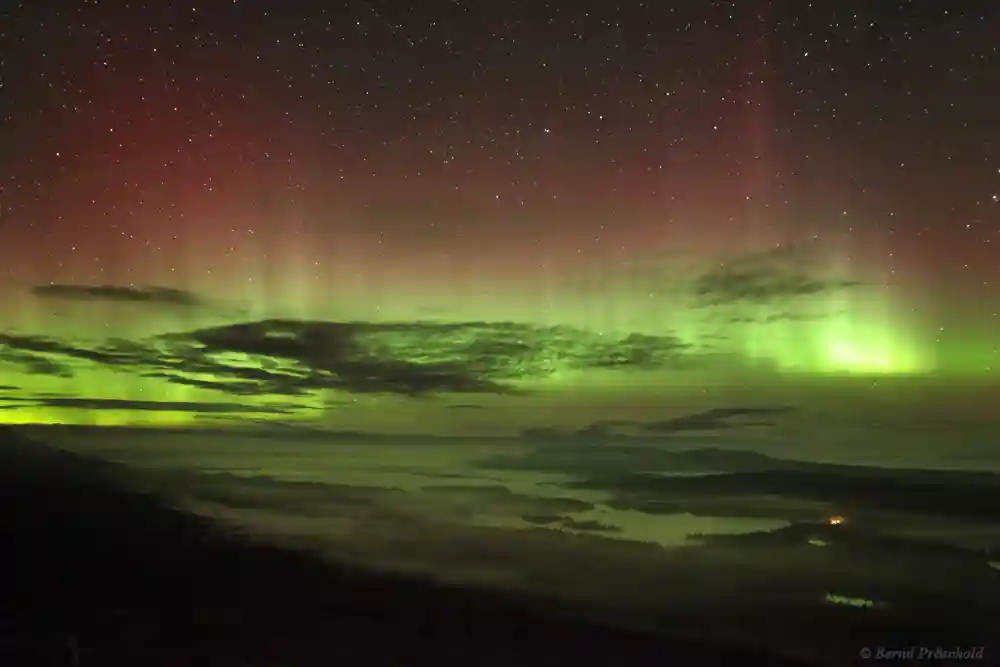The Hessdalen Lights have intrigued scientists, UFO enthusiasts, and mystery seekers for nearly a century. These strange, luminous phenomena have been observed periodically in a remote, 12-kilometer stretch of the Hessdalen Valley in Norway. Appearing both day and night, they drift through the valley, glowing white, yellow, or red, leaving behind more questions than answers. Despite ongoing research efforts that stretch back to the 1980s, the mystery of the Hessdalen Lights remains unresolved. Are they the result of a natural geological process, a rare atmospheric phenomenon, or do they suggest something far more extraordinary? The enigma persists, even as science attempts to catch up.
What We Know About the Hessdalen Lights
The Hessdalen Lights phenomenon has been recorded since the 1930s, though the lights gained international attention in the early 1980s when their activity surged. During the peak between 1981 and 1984, sightings were reported as frequently as 15-20 times a week, attracting tourists and researchers alike to the remote Norwegian valley. Witnesses described the lights as brilliant orbs that either hover in place or move at incredible speeds, sometimes swaying gently or performing sharp, erratic movements. Their duration varies from a few seconds to over an hour.

The lights have continued to appear sporadically over the years, albeit with less frequency. By 2010, annual sightings had decreased to about 10-20 a year. Despite this, the allure of the Hessdalen Lights remains strong, attracting both scientific expeditions and curious onlookers.
Key Characteristics of the Lights
The Hessdalen Lights exhibit several recurring features:
- Color: The lights are typically white, yellow, or red, although other colors, such as green, have also been reported.
- Movement: They can move rapidly across the sky or hover motionless. Their speed has been measured at up to 30,000 kilometers per hour (about 18,640 miles per hour).
- Shape: While generally orb-shaped, the lights have also been observed taking on geometric forms, including pyramids and helixes.
- Location: The lights are mostly confined to a 12-kilometer stretch of the valley, appearing both above and below the horizon.
Scientific Efforts to Investigate
Since 1983, multiple research initiatives have been launched to study the lights, starting with Project Hessdalen, a collaboration between UFO-Norge and UFO-Sverige. This project laid the groundwork for the Hessdalen Automatic Measurement Station (AMS), established in 1998, which continues to monitor the valley with cameras, magnetometers, and other sensors.
In the late 1990s, another major effort—The Triangle Project—recorded the lights in a distinctive pyramid shape. More recently, EMBLA, an international collaboration between Norwegian and Italian scientists, has continued to gather data in hopes of finding a conclusive explanation. Despite decades of research, however, a comprehensive understanding of the Hessdalen Lights remains elusive.
Unexplained Elements
While scientific study has shed some light on the phenomenon, several aspects of the Hessdalen Lights defy explanation.
Geographic Uniqueness
One of the most baffling questions is why the lights are concentrated in the Hessdalen Valley. The geology of the region, which includes quartz-rich rocks and metal deposits, has been suggested as a possible cause. However, similar geological formations exist worldwide, yet they do not exhibit the same light phenomena. This geographic specificity continues to puzzle researchers.
Electromagnetic Properties
The lights emit electromagnetic radiation across a broad spectrum, including visible light and infrared. While this suggests they may be a form of plasma—a hot, ionized gas—plasma alone doesn’t fully explain their erratic movements or longevity. Moreover, their ability to appear and disappear without warning adds another layer of complexity.
Spectral Observations
Spectroscopic analysis of the Hessdalen Lights has revealed several intriguing features, including helium emissions and ionized oxygen, both of which suggest some form of interaction with the Earth’s atmosphere. However, the precise mechanism remains unclear. Some lights display geometrical structures and emit a spectrum typical of dense, ionized gas, leading to the theory that the lights may be related to plasma physics.
Theories and Speculation
Given the enigmatic nature of the Hessdalen Lights, a range of theories has been proposed, some rooted in science, others in speculation. While none have been definitively proven, each offers a potential piece of the puzzle.
1. Plasma Phenomenon and Radon Decay
One of the more scientifically grounded theories suggests that the lights are caused by plasma, a form of ionized gas. In particular, some researchers point to radon decay in the valley’s atmosphere. Radon is a naturally occurring radioactive gas found in the Earth’s crust. When it decays, it releases alpha particles that ionize the surrounding air and dust, potentially forming glowing plasma. According to this theory, the lights may be clusters of Coulomb crystals in a dusty plasma, explaining their erratic motion and glowing appearance.

Interestingly, this theory of electrically charged materials has parallels in ancient technology, where mechanisms involving electricity-like properties were utilized in surprising ways. For example, you can explore how Ancient Egyptian Locks used security systems based on clever mechanisms, drawing an unexpected connection between ancient knowledge and modern scientific phenomena.
However, piezoelectricity doesn’t fully explain the entire spectrum of the Hessdalen Lights’ behavior, such as their ability to change colors and shapes. More recent research suggests that ionization, particularly from radon decay, might play a key role. Radon is a naturally occurring radioactive gas that, when it decays, releases alpha particles that ionize surrounding air and dust, potentially creating plasma-like conditions. This ionization process is further detailed in this Radon Decay Explained article, which offers insight into how such radioactive emissions could contribute to the formation of the lights.
2. Piezoelectricity from Quartz Rocks
Another hypothesis links the lights to piezoelectricity, a process by which certain materials, such as quartz, generate electrical charges under mechanical stress. The Hessdalen Valley’s geological composition, which includes quartz-rich rocks, could create electrical discharges when strained by tectonic movements. This might explain the lights’ appearance in the valley, but it doesn’t account for all the observed phenomena, such as their geometric shapes and prolonged duration.

3. Dust Plasma and Electromagnetic Waves
In 2010, a new model was proposed that combines elements of plasma physics with piezoelectric effects. According to this theory, the lights may form through a complex interaction between dusty plasma and low-frequency electromagnetic waves. When dust particles in the atmosphere are ionized, they could organize into structures resembling the shapes often reported in Hessdalen. This model explains the observed spectral emissions, including the presence of ionized oxygen, which gives the lights their distinctive colors.
4. Misidentification of Astronomical Bodies
Some sightings of the Hessdalen Lights have been attributed to misidentified astronomical phenomena, such as the planet Venus, distant aircraft, or reflections from car headlights. While these explanations may account for a small percentage of reports, they do not explain the more complex sightings that involve high-speed movement and changes in shape.
5. Extraterrestrial or Supernatural Theories
Given the lights’ mysterious nature and their defiance of simple explanations, it’s no surprise that some have proposed extraterrestrial involvement. Proponents of this theory argue that the lights’ intelligent movements and response to observers suggest they could be signals or craft from another world. While these ideas are largely speculative, they remain popular among UFO enthusiasts.
Frequently Asked Questions (FAQs)
1. What are the Hessdalen Lights?
The Hessdalen Lights are unexplained luminous phenomena observed in Hessdalen Valley, Norway. They appear as glowing orbs of various colors, often moving erratically through the sky.
2. Have the Hessdalen Lights been explained?
Although several theories exist, including plasma formations and piezoelectricity, no single explanation fully accounts for all aspects of the phenomenon.
3. Can the Hessdalen Lights be seen live?
Yes, a live webcam is set up in the Hessdalen Valley to monitor the lights, allowing enthusiasts and researchers to watch them in real-time.
4. What causes the Hessdalen Lights to appear?
The exact cause remains unknown, but scientific theories suggest they may be related to atmospheric plasma, radon decay, or geological electrical discharges.
5. How often do the Hessdalen Lights appear?
The lights appeared frequently in the early 1980s but have since become rarer, with only 10-20 sightings per year in recent times.
A Mystery Waiting to be Solved
Despite decades of study and numerous scientific expeditions, the Hessdalen Lights continue to confound researchers. Theories ranging from plasma physics and piezoelectricity to extraterrestrial involvement offer potential explanations, but none have been definitively proven. As technology advances, new research may finally unlock the secrets of this long-standing mystery, but for now, the Hessdalen Lights remain one of nature’s most enigmatic displays.
Use of Our Content
⚠️ Content on “Mystery Uncover” is protected under US and International Copyright Laws.
You are free to reuse, republish, and share our content by giving credit to the source as Mystery Uncover with a link to the original material on mysteryuncover.com.





